Wisconsin Union Theater celebrates history on eve of renovations
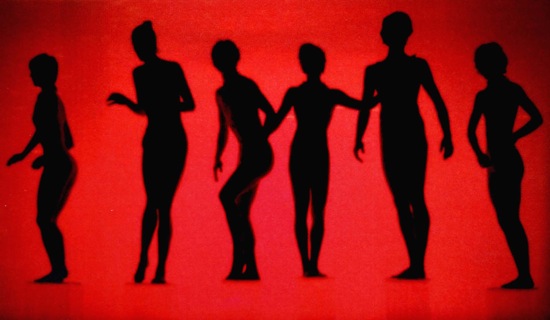
Members of the Nikolais Dance Theatre appear in silhouette in 1978.
Photo by Ralph Sandler.
In a theater, the ghost light – a naked bulb lamp left onstage while the rest of the lights are dark – has a practical purpose, preventing people from tripping or fumbling in the night.
Some traditions, however, hold that the presence of a ghost light appeases the ghosts, real or imagined, who might curse the theater’s productions.
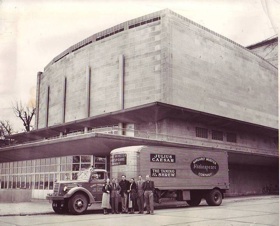
The Margaret Webster Shakespeare Company arrives for its performance of “The Taming of the Shrew” in 1949.
“We have two ghosts,” says Esty Dinur, marketing and communications director for the Wisconsin Union Theater, as if simply describing the number of spotlights or seats in the hall.
“One died while working on the building. The other was the timpanist of the Minneapolis Symphony; he died while playing here,” she says.
Standing on the worn Union Theater stage, it’s hard to ignore the spirit of the performers and workers of the past eight decades. Reminders of the theater’s history line the walls: posters of Henry Fonda, Alfred Lunt and Lynn Fontanne, Harry Belafonte and others. The tiny “star” dressing room, still charming visitors with its Art Deco lines, has held everyone from Paul Robeson to Kurt Vonnegut.
As the Wisconsin Union Theater closes for a two-year renovation, staffers are opening doors to the public in two farewell events.
On Saturday, May 12, a Curtain Down Party and open house will allow patrons of all ages to explore areas rarely open to the public. Spilling out from the stage into the lobby and Play Circle, among other locations, visitors can try on costumes in the original dressing rooms, peruse historical displays and memorabilia giveaways in the Winkler Lounge, and record theater memories in the green room. Forty-five-minute tours will take place throughout the afternoon. The event, running from 2-6 p.m., is free and open to the public.
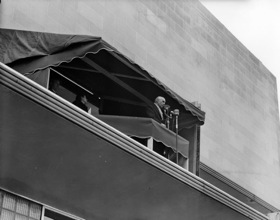
Jawaharlal Nehru, the first prime minister of India, speaks to a crowd gathered at the Terrace from the outdoor balcony of the Union Theater in 1949.
Photo: Wisconsin Historical Society.
A gala event on Thursday, May 31 will reflect on the theater’s storied history. Wisconsin Union director Mark Guthier and Union Theater director Ralph Russo host a special program featuring local performers. Tickets are $73, with $40 of the price tax-deductible, and include cocktails, hors d’oeuvres, tours, and much more. (For information, contact Heather Good at 608-263-6825 or unionalumni@union.wisc.edu.)
Many other spaces on campus are known for one or two functions. The Mosse Humanities Building’s Mills Hall, for example, hosts music performances; the H’Doubler Performance Space in Lathrop Hall features dance.
The Union Theater, however, holds Distinguished Lecture Series events, high school conventions, the Wisconsin Film Festival, and ensembles from two to over a hundred musicians and dancers.
In the green room, named for theater pioneer Fan Taylor, a massive poster lists the complete Concert Series history, including ten years before the theater opened. The list includes Kirsten Flagstad, Jascha Heifetz, Fritz Kreisler, Dame Myra Hess: the biggest names in 20th century classical music.
“Everyone who’s anyone has been here,” says Dinur. “Artists get onstage and think, ‘I can’t believe I’m playing where Isaac Stern used to play!’”
The theater’s acoustics have drawn raves since the day they opened – literally.
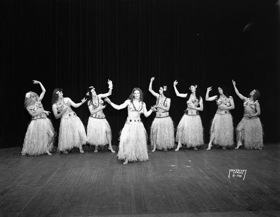
Sergeant Henry Hale Uhar and seven other soldiers, dressed as “Hawaiian maidens,” perform a scene from the “Wac-Khaki” GI Revue during World War II.
Photo: Wisconsin Historical Society.
Alfred Lunt, half of the “first couple of American theatre,” joined wife Lynn Fontanne in 1939 for four performances of Shakespeare’s “The Taming of the Shrew.”
“The acoustics are simply marvelous,” remarked Lunt, on opening night.
The architects have taken great pains to maintain acoustic integrity in the new space. Also remaining: much of the Art Deco style, along with the wide aisles that encourage conversation. The chairs, many original, will be replaced with similar but larger styles.
Few, however, will miss the Union’s architectural afterthoughts. Simply getting to the ice cream stand requires a twisting, stair-climbing expedition, or a walk outside.
“Inaccessibility has been a huge problem,” says senior Ben Ferris, the incoming director of the Wisconsin Union Directorate’s Performing Arts Committee. “I was unable to bring my grandmother to events; we weren’t able to get to a restroom quickly. Adding an elevator will be a big help. The box office itself will be accessible, too.”
Dinur doesn’t mince words about another major challenge.
“Our offices have been horrible. Our HVAC system is nonexistent,” Dinur says.
Staffers and performers alike have bemoaned the temperature fluctuations and noise caused by the theater’s 1939 ventilation – serious concerns, rarely fixable. Displaced air systems will provide more comfortable space, reduce noise and eliminate drafts.
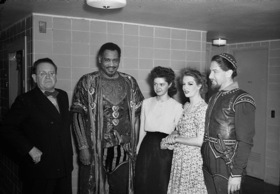
Left to right: Oskar Hagen, founder of the art history department; Paul Robeson as Othello; Madison resident Barbara Anderson; Uta Hagen (daughter of Oskar Hagen), as Desdemona; and José Ferrer, then Uta Hagen’s husband, as Iago. They appeared at the theater in 1944.
Photo: Wisconsin Historical Society
“When the folks came in to assess the heating system, they said, ‘You can’t get rid of this; it should be part of a museum,’” laughs Ferris. “’The fact that this still does anything is spectacular.’”
The green room itself will make way for a new space called the Studio Room, used for rehearsal. The splintered wooden surface of the stage – operations manager Bruce Ehlinger isn’t sure if it’s ever been replaced – will become a sprung floor, sure to please the legions of dancers.
The theater’s wide variety means that many campus spaces will host events while the theater is closed. Union South will host shows in the Sett and the Travel Adventure Series in the Marquee. The Concert Series will relocate to Mills Hall; other performances will take place in Music Hall.
Ferris hopes to finalize more unusual events: something in the Wisconsin Institutes for Discovery, perhaps, or a collaboration between a touring “new music” pioneer and dancers. He hopes to increase interaction with these nationally known artists through master classes and other opportunities.
Just as the events will relocate across campus, the personnel will spread out as well. Dinur will move to the Union’s marketing area, remaining in the Memorial Union with Ehlinger. Box office manager Ted Harks is moving to Vilas Hall; other staffers will take refuge in Union South cubicles.
On Friday, June 1, the day after the gala, the theater will host its final event: Isthmus Jazz Festival headliner Mary Stallings. The event will be free and unticketed, a first for the festival, in celebration.
The ghost light will go dark, then, as the theater undergoes its transformation. When it reopens in 2014, the spirit will return – just in time for the theater’s 75th anniversary.
“It’s one of these ‘if these walls could talk’ situations,” says Dinur. “So many incredible stories.”
Tags: arts, events, Wisconsin Union




